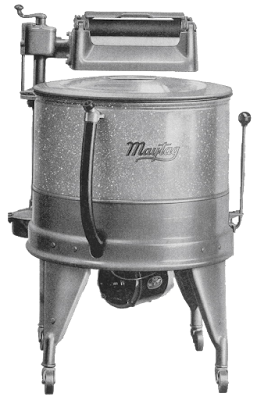Thursday, April 6, 2023
The history of the washing machines
Ancient peoples cleaned their clothes by pounding them on rocks or rubbing them with abrasive sands and washing the dirt away in local streams. Evidence of ancient washing soap was found at Sapo Hill in Rome, where the ashes containing the fat of sacrificial animals was used as a soap.
On ships, the crew washed their clothes by placing the dirty laundry in a strong cloth bag, and tossing it overboard, letting the ship drag the bag for hours. The principle was sound: forcing water through clothes to remove dirt.
The earliest washing "machine" was the scrub board invented in 1797. It would not be until the 19th century when steam power would be used in washing machine designs.
American James King patented the first washing machine to use a drum in 1851 - the drum made King's machine resemble a modern machine; however, it was still hand-powered.
In 1858, Hamilton Smith patented the first rotary washing machine. Less than 20 years later, in 1874, William Blackstone built a birthday present for his wife. It was a machine which removed and washed away dirt from clothes. This was the first washing machine designed for convenient use in the home.
Electric washing machines were advertised and discussed in newspapers as early as 1904. Alva J. Fisher has been incorrectly credited with the invention of the electric washer. The "inventor" of the electric washing machine remains unknown.
The first completely electric-powered washing machine was named "The Thor", invented by Alva J. Fisher. It was introduced in 1908 by the Hurley Machine Company of Chicago, Illinois. A patent was issued on August 9th 1910. The Thor was a drum type washing machine with a galvanized tub and an electric motor. One of the biggest problems of early electric washing machines was that the water often ran to electrical parts. This resulted in short circuits, sparks and overheating.
It is presumed that the first laundromat opened in Fort Worth, Texas in 1934. It was run by Andrew Clein. Patrons used coin-in-the-slot facilities to rent washing machines.
Washer design improved during the 1930s. The mechanism was now enclosed within a cabinet, and more attention was paid to electrical and mechanical safety. Spin dryers were introduced to replace the dangerous power mangle/wringers of the day.
Bendix Corporation introduced the first domestic automatic washing machine in 1937, having applied for a patent in the same year.
Over time manufacturers of automatic washers have gone to great lengths to reduce cost. For instance, expensive gearboxes are no longer required, since motor speed can be controlled electronically.
In 1978, the first microchip-controlled automatic washing machines were produced. In the early 1990s, upmarket machines incorporated microcontrollers for the timing process. These proved reliable and cost-effective, so many cheaper machines now also incorporate microcontrollers rather than electromechanical timers.
In 1998, New Zealand-based company Fisher & Paykel introduced its SmartDrive washing machine line in the US. This washing machine uses a computer-controlled system to determine certain factors such as load size and automatically adjusts the wash cycle to match. It also used a mixed system of washing, first with the "Eco-Active" wash, using a low level of recirculated water being sprayed on the load followed by a more traditional style wash. The SmartDrive also included direct drive brushless DC electric motor, which simplified the bowl and agitator drive by doing away with the need for a gearbox system.
In 2008, the University of Leeds created a concept washing machine that uses only a cup (less than 300 milliliters) of water and 20 kilograms of re-usable plastic beads to carry out a full wash. The machine leaves clothes virtually dry, and uses less than 2 % of the water and energy otherwise used by a conventional machine. As such, it could save billions of liters of water each year.









